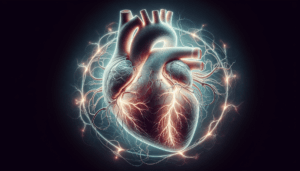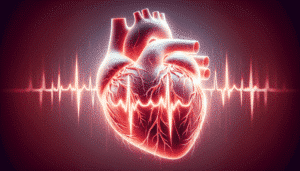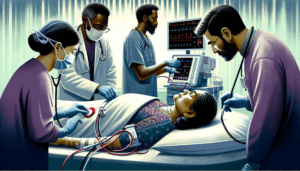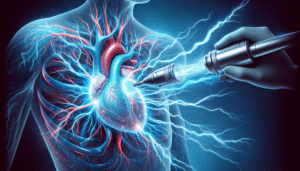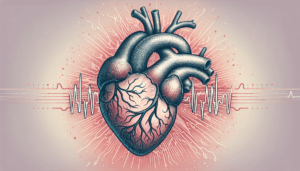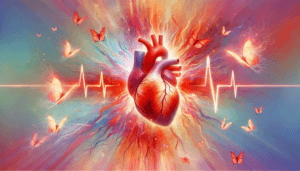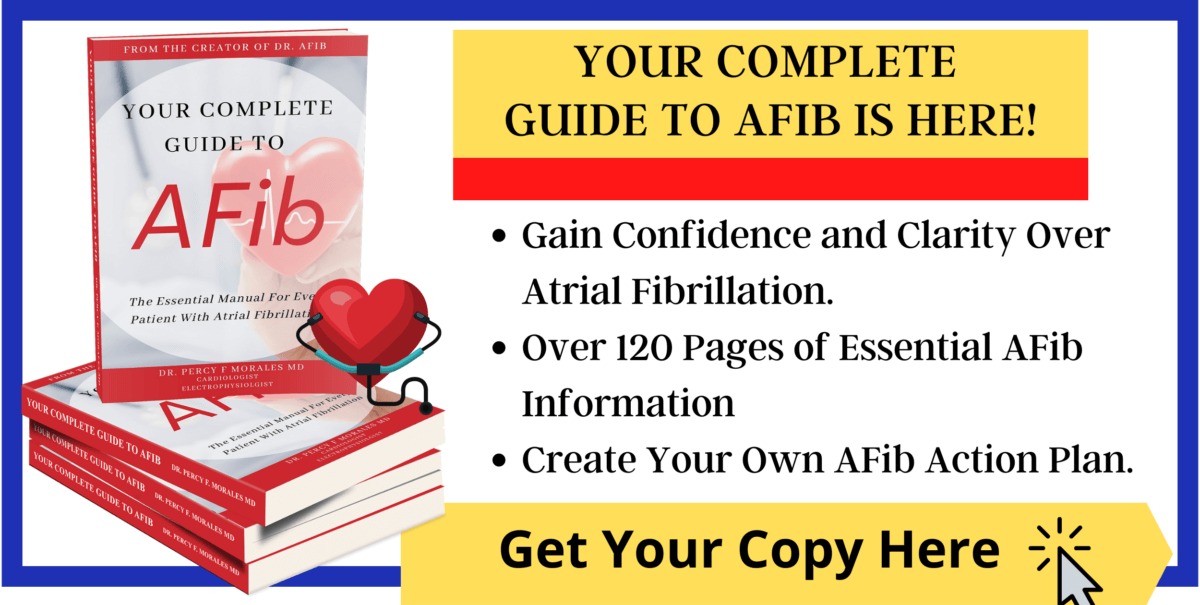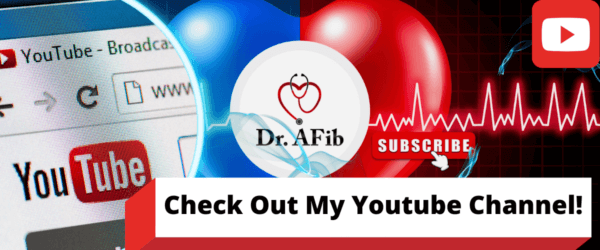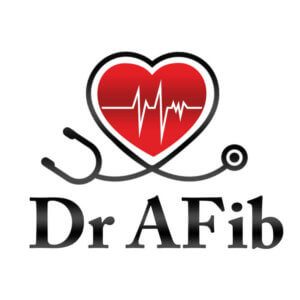Learn more about when to go to the hospital for rapid heart rate in this article. Imagine the sudden feeling of a heart racing, accompanied by dizziness and chest pain. A trip to the emergency room reveals that you have a rapid heart rate, also known as tachycardia. In this blog post, we will explore the signs of a rapid heart rate, the factors contributing to it, and the various types of irregular heart rhythms. We will also discuss when to go to the hospital for a rapid heart rate, when to seek emergency medical attention, and how to maintain a healthy heart rate to prevent serious health complications.
Key Takeaways
Recognize rapid heart rate symptoms and understand causes, types, and treatments.
Measure your heart rate to identify tachycardia. Physical exertion, stress, anxiety or underlying health conditions can contribute to it.
Seek emergency medical attention if experiencing chest pain/shortness of breath & adopt a healthy lifestyle for prevention.
Recognizing a Rapid Heart Rate
Recognizing a rapid heart rate involves being aware of symptoms such as heart palpitations, dizziness, and shortness of breath.
Tachycardia is a medical condition characterized by a heart rate that exceeds the normal resting rate. Typically, it’s defined as a heart rate over 100 beats per minute in adults, while at rest. It can be caused by various factors such as stress, anxiety, physical exertion, certain medications, or underlying health conditions.
Although a rapid heart rate may not always lead to severe health issues, it could increase the risk of serious health problems if left untreated.
When to Go to the Hospital for Rapid Heart Rate: Identifying Tachycardia
Tachycardia, a heart rate exceeding 100 beats per minute at rest, can last from seconds to hours, to even days or weeks, and may lead to serious health problems if untreated. There are various types of tachycardia, such as sinus tachycardia, atrial fibrillation, and atrial flutter, to name a few, which can be attributed to factors like exercising, emotional stress, medications, or underlying medical conditions. Several causes of tachycardia will be discussed in this article.
Being aware of tachycardia symptoms such as dizziness, tiredness, or chest discomfort is important. The potential ramifications of untreated tachycardia could include an increased likelihood of forming a blood clot that could precipitate a stroke or heart attack, as well as other health potential complications.
Treatment for tachycardia can include several options:
treatment of underlying cause of tachycardia
medications
cardioversion shock
invasive procedures such as an electrophysiology study
Measuring Your Heart Rate
Measuring your heart rate can be done by checking your pulse at the carotid or radial artery and counting the beats for a specific duration, then multiplying to get beats per minute. To locate your carotid artery, position two fingers beneath the angle of your jaw on one side of your windpipe.
You can take your pulse at the radial artery located on the side of your thumb. This artery is commonly used for finding the pulse. This simple technique can help you monitor your heart rate and identify any irregularities in your heart’s rhythm.
There are numerous devices available that allow individuals to measure their heart rate at home. Blood pressure cuffs, fitness trackers, smartwatches, and heart rate monitor chest straps are popular choices due to their ease of use and accuracy. Additionally, there are handheld devices known as pulse oximeters that not only measure heart rate but also oxygen saturation in the blood. It’s important to note that while these devices provide useful information, they should not replace regular check-ups with a healthcare professional.
Factors Contributing to a Rapid Heart Rate
Various factors contribute to a rapid heart rate, including:
Physical exertion
Stress
Anxiety
Caffeine or alcohol intake
Medications
Underlying health conditions
Physical exertion, defined as any activity that increases the heart rate and breathing rate, is a common cause of a temporary increase in heart rate. However, it is abnormal to have a sustained elevated heart rate while at rest.
In some cases, certain medications may produce tachycardia as a side effect. Additionally, an abnormal heart rhythm may result from high blood pressure, heart disease, or other medical conditions.
Addressing underlying issues, maintaining a healthy weight, and effectively managing stress levels can help prevent tachycardia. Focusing on heart health and a balanced lifestyle can help minimize the risk of experiencing a rapid heart rate.
Underlying Medical Conditions that Cause Tachycardia
Underlying medical conditions can often be the root cause of tachycardia. Conditions such as anemia, heart disease, high blood pressure, hyperthyroidism, vitamin deficiencies, and certain lung conditions can lead to an abnormally fast heart rate. Furthermore, some people might have a genetic predisposition to tachycardia, owing to inherited heart abnormalities. Other factors like excessive alcohol consumption, smoking, or use of recreational drugs can also trigger this condition..
Treating the underlying cause of tachycardia is crucial in managing this condition effectively. By addressing the root cause, whether it is a lifestyle factor or a chronic disease, the symptoms of tachycardia can be significantly reduced or even eliminated. This approach not only helps in controlling the heart rate but also improves the overall health of the individual, reducing the risk of potential complications such as stroke, heart failure, or sudden cardiac death.
Sinus Tachycardia
Sinus tachycardia is a type of tachycardia that originates from the sinus node, the natural pacemaker of the heart. It’s characterized by a faster-than-normal heart rate — typically over 100 beats per minute in adults — while retaining a regular rhythm. While sinus tachycardia can be a normal response to factors like physical exertion or emotional stress, it can also be a sign of an underlying health condition.
Common causes of sinus tachycardia include:
Physical activity
Emotional distress
High fever
Dehydration
Certain medications
Medical conditions such as anemia, hyperthyroidism, or heart disease.
Supraventricular Tachycardia (SVT)
Supraventricular Tachycardia, commonly known as SVT, is a type of abnormal heart rhythm that originates from the upper chambers of the heart, specifically above the ventricles, hence the term ‘supraventricular’. SVT is characterized by a rapid heart rate, often ranging from 100 to 250 beats per minute, which is significantly faster than the normal heart rate. The rapid heartbeat in SVT is caused by a malfunction in the electrical system of the heart, where the electrical signals that regulate the heart rate misfire, leading to a faster than normal heart rate. This can result in symptoms such as palpitations, chest discomfort, shortness of breath, and in severe cases, loss of consciousness. SVT can occur in healthy individuals and may be triggered by stress, excessive caffeine or alcohol consumption, smoking, certain medications, or underlying heart conditions.
Types of Irregular Heart Rhythms
Several irregular heart rhythms can also cause a rapid heart rate. These irregular heart rhythms are rhythms that do not originate from the sinus node, the heart’s natural pacemaker. Irregular heart rhythms that can cause a rapid heart rate include:
Atrial fibrillation
Atrial flutter
Ventricular tachycardia
Ventricular fibrillation
All of these irregular rhythms can cause a fast heart rate. These types of irregular heart rhythms are categorized based on the affected chamber and ventricle in the heart.
Comprehending the various types of irregular heart rhythms and their possible consequences aids in maintaining overall heart health.
Atrial Fibrillation and Flutter
Atrial fibrillation (also called AFib) and atrial flutter are rapid and irregular heartbeats in the upper chambers of the heart, which can increase the risk of stroke and may require treatment with medication or cardiac ablation. Some individuals may not be aware of atrial fibrillation and may not experience any symptoms, while others may encounter distressing indications such as palpitations, dizziness, and shortness of breath.
These conditions reduce the heart’s blood pumping efficiency, thus increasing the risk of blood clots, heart failure, and stroke. Treatment options for atrial fibrillation include anti-arrhythmic medication, cardiac ablation, or administering a shock to a sedated patient’s heart to restore a normal rhythm.
For proper care and management, it is advisable to consult an electrophysiologist who specializes in diagnosing and treating heart rhythm problems, including atrial fibrillation.
Read more about common AFib symptoms here.
Read more about common AFib treatment here.
Your Complete Guide To AFib: The Essential Manual For Every Patient With Atrial Fibrillation
$15.95 (as of May 28, 2025 06:41 GMT -06:00 – More infoProduct prices and availability are accurate as of the date/time indicated and are subject to change. Any price and availability information displayed on [relevant Amazon Site(s), as applicable] at the time of purchase will apply to the purchase of this product.)Ventricular Tachycardia and Fibrillation
Ventricular tachycardia and fibrillation are serious arrhythmias that can lead to cardiac arrest and require immediate medical attention. Ventricular tachycardia is a potentially fatal condition in which the electrical stimulus for the heartbeat originates from a ventricle rather than the upper atria. Sustained ventricular tachycardia can result in cardiac arrest due to the heart’s inability to supply sufficient blood to the brain and other organs.
Ventricular fibrillation is the most dangerous rapid heart rhythm, wherein the heart’s electrical system in the ventricles transmits disorganized signals at a rapid rate, rendering the heart incapable of beating efficiently and supplying blood to the rest of the body. Performing cardiopulmonary resuscitation (CPR) and seeking immediate medical help with likely defibrillation is necessary with ventricular tachycardia or fibrillation.
When to Go to the Hospital for Rapid Heart Rate: Know When to Seek Emergency Medical Attention
In general, there is no clear rapid heart rate that defines when it is necessary to seek emergency medical attention for a rapid heart rate. I have personally have had patients with tachycardia for weeks at a time which have been stable for outpatient medical therapy. In general, it is the severity of symptoms which are a better gauge of when it is appropriate to seek emergency medical care.
Seeking emergency medical attention is crucial for a rapid heart rate if it occurs at rest without a clear cause or is accompanied by:
Chest pain
Shortness of breath
Fainting
Loss of consciousness
These symptoms may indicate an underlying heart condition or a life-threatening situation that requires prompt medical attention.
If you have severe symptoms due to tachycardia, do not hesitate to visit a hospital for rapid heart or an emergency room, where expert healthcare providers can evaluate your condition and provide appropriate care. Remember, timely medical intervention can make a significant difference in preventing severe complications such as a heart attack or stroke.
Maintaining a Healthy Heart Rate
Maintaining a healthy heart rate involves a balanced diet and regular exercise. Adopting a nutritious diet and engaging in regular physical activity are beneficial for sustaining a healthy heart rate.
Diet and Exercise
Heart health is greatly influenced by diet and exercise, with recommendations including consuming fruits, vegetables, whole grains, and limiting saturated fats, as well as engaging in 30-45 minutes of physical activity several times a week. Some examples of beneficial physical activities include going for a stroll, cycling, or swimming. These activities not only promote heart health, but also contribute to overall well-being.
Maintaining a healthy weight and incorporating healthy fats into your diet is beneficial. Some sources of healthy fats include:
Fish
Lean meats
Nuts
Beans
By adhering to a heart-healthy diet and engaging in regular exercise, one can effectively manage and maintain a healthy heart rate.
Risk Factors and Prevention
Risk factors for tachycardia include:
Age
Family history of arrhythmias
Lifestyle choices
Medical conditions such as high blood pressure and obesity
Addressing these risk factors and adopting a heart-healthy lifestyle is a key step in preventing tachycardia and maintaining a healthy heart rate.
Prevention involves maintaining a healthy lifestyle, managing stress, and taking prescribed medications as directed. By focusing on heart health, managing underlying conditions, and making conscious lifestyle choices, individuals can effectively minimize the risk of experiencing a rapid heart rate and its associated complications.
Summary
In summary, recognizing and addressing a rapid heart rate is essential for overall heart health. Understanding the signs of tachycardia, the factors contributing to a rapid heart rate, and the various types of irregular heart rhythms can help individuals take the necessary steps to maintain a healthy heart rate. Seeking emergency medical attention when needed and adopting a heart-healthy lifestyle are crucial for preventing severe complications and sustaining optimal heart health.
Take control of your heart health by monitoring your heart rate, making informed decisions about your diet and exercise routine, and seeking medical attention when necessary. Remember, your heart is the engine that powers your body – treat it with care, and it will keep you strong and healthy for years to come.
Frequently Asked Questions
What is a dangerously fast heart rate?
There is no clear definition or cutoff value for what is considered a dangerous heart rate, since patients experience rapid heart rates with different symptoms. In general, symptoms are more of a concern then the actual heart rate value. In general, when patients have heart rates over 150 bpm, they are frequently symptomatic and require urgent medical attention.
How long is too long for tachycardia?
There is no clear definition or cutoff value for duration for what is considered too long for tachycardia. I have had many patients with rapid heart rates for weeks at a time that have been stable for outpatient treatment. Symptoms such as chest pain or shortness of breath are more of an accurate indicator for urgent need for medical attention then duration of tachycardia.
How do you calm a racing heart?
To calm a racing heart, deep breathing can help to let your body know that there is no danger, and relaxation techniques such as yoga, meditation or taking slow breaths can also be beneficial.
Additionally, avoid stimulants such as caffeine or nicotine, and try splashing your face with cold water to stimulate a nerve that controls your heart rate.
What factors can contribute to a rapid heart rate?
Physical exertion, stress, anxiety, caffeine and alcohol intake, medications, and underlying heart conditions can all contribute to a rapid heart rate.
What will the hospital do for tachycardia?
When you visit the hospital for tachycardia, the healthcare team will first stabilize your condition and then work to identify the cause of your rapid heart rate. This process may involve a series of diagnostic tests, such as an electrocardiogram (ECG), blood tests, and possibly an echocardiogram.
Depending on the severity and cause of your tachycardia, different treatments may be recommended. These can include intravenous medications to control your heart rate or rhythm (metoprolol or cardizem are commonly used options), procedures to correct abnormal electrical pathways in your heart, or even surgery in severe cases. In addition, lifestyle changes and management of underlying conditions will be recommended to prevent future episodes.
The Best Atrial Fibrillation Book
Your Complete Guide To AFib: The Essential Manual For Every Patient With Atrial Fibrillation
$15.95 (as of May 28, 2025 06:41 GMT -06:00 - More infoProduct prices and availability are accurate as of the date/time indicated and are subject to change. Any price and availability information displayed on [relevant Amazon Site(s), as applicable] at the time of purchase will apply to the purchase of this product.) The A to Z guide on everything you need to know about atrial fibrillation. Written by AFib expert Dr. Percy Morales MD. Over 120 pages of essential information on medications, procedures, and lifestyles modifications for AFib. Easy to read for every patient.
Shop AFib Products on Amazon
KardiaMobile 6-Lead Personal EKG Monitor – Six Views of The Heart – Detects AFib and Irregular Arrhythmias – Instant Results in 30 Seconds – Works with Most Smartphones - FSA/HSA Eligible
13% Off
KardiaMobile 1-Lead Personal EKG Monitor – Record EKGs at Home – Detects AFib and Irregular Arrhythmias – Instant Results in 30 Seconds – Easy to Use – Works with Most Smartphones - FSA/HSA Eligible
$79.00 (as of May 28, 2025 05:51 GMT -06:00 - More infoProduct prices and availability are accurate as of the date/time indicated and are subject to change. Any price and availability information displayed on [relevant Amazon Site(s), as applicable] at the time of purchase will apply to the purchase of this product.)
Apple Watch Series 9 [GPS 41mm] Smartwatch with Storm Blue Aluminum Case with Silver Sport Band M/L. Fitness Tracker, Blood Oxygen & ECG Apps, Always-On Retina Display
(as of May 28, 2025 06:41 GMT -06:00 - More infoProduct prices and availability are accurate as of the date/time indicated and are subject to change. Any price and availability information displayed on [relevant Amazon Site(s), as applicable] at the time of purchase will apply to the purchase of this product.)
Fitbit Sense 2 Advanced Health and Fitness Smartwatch with Tools to Manage Stress and Sleep, ECG App, SpO2, 24/7 Heart Rate and GPS, Shadow Grey/Graphite, One Size (S & L Bands Included)

OMRON 2-in-1 Upper Arm Blood Pressure Monitor & 1-Lead EKG Monitor - Clinically Validated Blood Pressure Arm Cuff & Machine - Use OMRON Connect App
18% Off
Samsung Galaxy Watch 6 44mm Bluetooth Smartwatch, Fitness Tracker, Personalized HR Zones, Advanced Sleep Coaching, Heart Monitor, BIA Sensor, Health Wellness Insights, Big Screen, US Version, Graphite
9% Off
Natural Rhythm Triple Calm Magnesium 150 mg - 120 Capsules – Magnesium Complex Compound Supplement with Magnesium Glycinate, Malate, and Taurate. Calming Blend for Promoting Rest and Relaxation.
$20.77 ($0.17 / Count) (as of May 28, 2025 05:51 GMT -06:00 - More infoProduct prices and availability are accurate as of the date/time indicated and are subject to change. Any price and availability information displayed on [relevant Amazon Site(s), as applicable] at the time of purchase will apply to the purchase of this product.)
Pure Encapsulations Magnesium (Glycinate) - Supplement to Support Stress Relief, Sleep, Heart Health, Nerves, Muscles, and Metabolism* - with Magnesium Glycinate - 180 Capsules
$44.60 ($0.25 / Count) (as of May 28, 2025 06:46 GMT -06:00 - More infoProduct prices and availability are accurate as of the date/time indicated and are subject to change. Any price and availability information displayed on [relevant Amazon Site(s), as applicable] at the time of purchase will apply to the purchase of this product.)
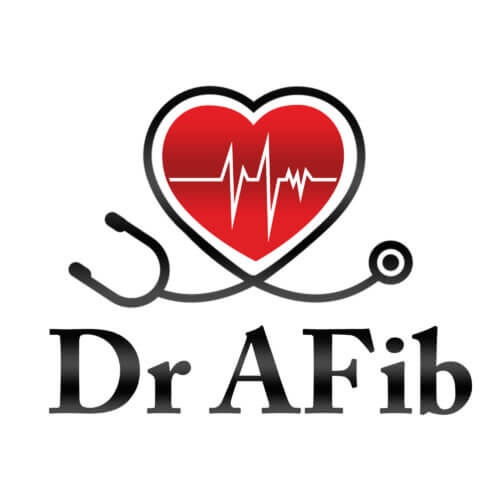
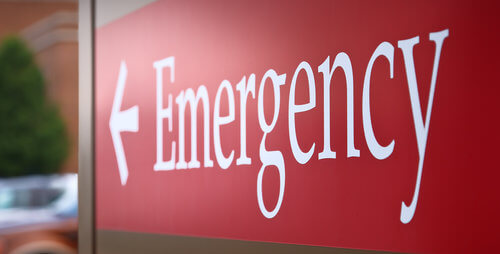














![Apple Watch Series 9 [GPS 41mm] Smartwatch with Storm Blue Aluminum Case with Silver Sport Band M/L. Fitness Tracker, Blood Oxygen & ECG Apps, Always-On Retina Display #1](https://m.media-amazon.com/images/I/311xwtp4mFL._SL100_.jpg)
![Apple Watch Series 9 [GPS 41mm] Smartwatch with Storm Blue Aluminum Case with Silver Sport Band M/L. Fitness Tracker, Blood Oxygen & ECG Apps, Always-On Retina Display #2](https://m.media-amazon.com/images/I/41j+8AaUGsL._SL100_.jpg)
![Apple Watch Series 9 [GPS 41mm] Smartwatch with Storm Blue Aluminum Case with Silver Sport Band M/L. Fitness Tracker, Blood Oxygen & ECG Apps, Always-On Retina Display #3](https://m.media-amazon.com/images/I/41jIyxZitnL._SL100_.jpg)
![Apple Watch Series 9 [GPS 41mm] Smartwatch with Storm Blue Aluminum Case with Silver Sport Band M/L. Fitness Tracker, Blood Oxygen & ECG Apps, Always-On Retina Display #4](https://m.media-amazon.com/images/I/41IpNJERjCL._SL100_.jpg)
![Apple Watch Series 9 [GPS 41mm] Smartwatch with Storm Blue Aluminum Case with Silver Sport Band M/L. Fitness Tracker, Blood Oxygen & ECG Apps, Always-On Retina Display #5](https://m.media-amazon.com/images/I/31o17yhfYpL._SL100_.jpg)





























